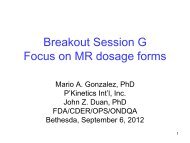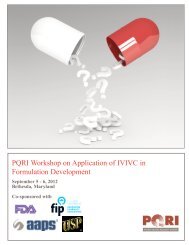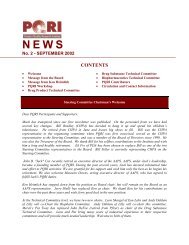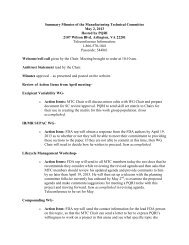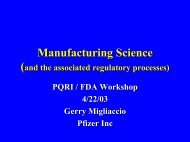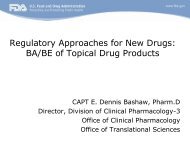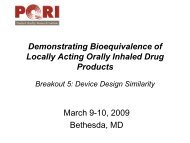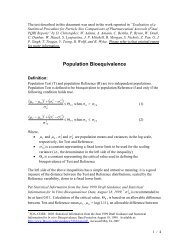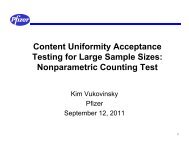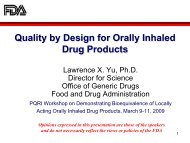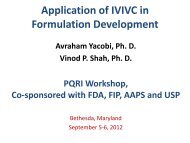Database of Potential Extractables - PQRI
Database of Potential Extractables - PQRI
Database of Potential Extractables - PQRI
- TAGS
- database
- extractables
- pqri
- pqri.org
You also want an ePaper? Increase the reach of your titles
YUMPU automatically turns print PDFs into web optimized ePapers that Google loves.
DATABASE OF POTENTIAL EXTRACTABLES<br />
Status Report<br />
Abstract<br />
Results<br />
Observations<br />
“Theory guides, experiments decides” – I.M. Kolth<strong>of</strong>f<br />
A list <strong>of</strong> potential extractables from different polymeric<br />
materials have been compiled and analyzed to develop<br />
predictive models that could aid in risk assessment<br />
regarding the toxicology, detection and migration <strong>of</strong><br />
these compounds into Parenteral and Ophthalmic Drug<br />
Products (PODP).<br />
Structural Activity Relationship (SAR) and Statistical<br />
Analysis computer programs are being applied to<br />
develop these models. The results from the controlled<br />
extraction experiments that are being conducted by the<br />
<strong>PQRI</strong>-PODP working group are being used to help<br />
“decide” the merits <strong>of</strong> the predictive models.<br />
Introduction<br />
A list <strong>of</strong> potential extractable compounds has been compiled<br />
based on:<br />
•Manufacturing sources: plasticizing and processing<br />
agents, anti-oxidants, lubricants, etc.<br />
• Published and non-published literature: reported<br />
extractable compounds and related substances.<br />
<strong>Database</strong> contains:<br />
• CAS numbers and chemical structures<br />
• Literature reported and SAR estimated physical<br />
properties<br />
• Formula weight<br />
• Boiling point<br />
• Partitioning value (Log P and Log D)<br />
.<br />
Process<br />
Development <strong>of</strong> predictive models:<br />
• Chemical structures – Derek and Cramer programs applied in<br />
the evaluation <strong>of</strong> potential toxic materials.<br />
• Physio/Chemical Properties – mathematical models applied<br />
in the evaluation <strong>of</strong> analytical range for chromatographic<br />
methods and the potential for the compounds to migrate from<br />
bulk material.<br />
Status <strong>of</strong> Investigations:<br />
• Toxicology :<br />
• Total <strong>of</strong> 612 compounds with structures have been<br />
compiled<br />
• Derek and Cramer analyses <strong>of</strong> listed compounds have<br />
been completed<br />
•Physio/Chemical Properties:<br />
FW, Log P, Log D and Boiling Point data for 125<br />
compounds have been complied<br />
• Conducted statistical analyses (e.g., Histograms and<br />
Quantile determinations) to assess the analytical range<br />
<strong>of</strong> the chromatographic methods as related to analyte<br />
partitioning.<br />
• Applied results from the statistical model to assess the<br />
pr<strong>of</strong>ile <strong>of</strong> the HPLC detected peaks in the five extraction<br />
studies to determine if improvements in the<br />
chromatographic methods can be made.<br />
Table 1: Example <strong>of</strong> SAR Toxicology <strong>Database</strong><br />
Structure CAS #<br />
Cl<br />
Br<br />
Cl<br />
H 2<br />
ON<br />
H<br />
Cl<br />
Br<br />
Cl<br />
O<br />
O<br />
OH<br />
OH<br />
CH 3<br />
NH 2<br />
OH<br />
Cramer<br />
Class<br />
Cramer comment<br />
79-34-5 3 Q3/4: Non-standard element - Chlorine (alkyl)<br />
3018-20-0 3<br />
88-99-3 1 Q18: No alerting features<br />
Q33/29: Polyaromatic compound without sufficient<br />
sulphate groups<br />
624-20-4 3 Q3/4: Non-standard element - Bromine (alkyl)<br />
108-45-2 3 Q33/32: Insufficient sulphate groups<br />
1081-75-0 3<br />
110-63-4 1 Q18: No alerting features<br />
Q33/29: Polyaromatic compound without sufficient<br />
sulphate groups<br />
Table 2: Example <strong>of</strong> Physio/Chemical Property <strong>Database</strong><br />
CAS # FW Log P Log D pH 4 Log D pH 7 Log D pH 10 BP [°C]<br />
100-21-0 166.13 2.00 1.44 -2.14 -2.15 392<br />
100-41-4 106.17 3.23 3.23 3.23 3.23 136<br />
100-51-6 108.13 1.06 1.06 1.06 1.06 205<br />
100-52-7 106.12 1.45 1.45 1.45 1.45 180<br />
101-77-9 198.21 1.63 -0.08 1.63 1.64 398<br />
102-06-7 211.26 2.36 0.36 0.39 2.00 321<br />
103-23-1 370.57 8.10 8.10 8.10 8.10 374<br />
• Log P is a measure <strong>of</strong> the hydrophobicity (+ values) or hydrophilicity (- values) <strong>of</strong> a<br />
neutral or non-ionizable compound.<br />
•Log D is a measure <strong>of</strong> the hydrophobicity (+ values) or hydrophilicity (- values) <strong>of</strong><br />
a substance at a specified pH. If the compound is not ionizable in the aqueous than<br />
Log D = Log P<br />
Figure 1: 3D Contour Plot <strong>of</strong> BP, Log P and FW<br />
Data for Listed Compounds in <strong>Database</strong><br />
Figure 2: Histogram Pr<strong>of</strong>iles <strong>of</strong> Formula Weight<br />
[Daltons], Boiling Point [°C] and Log P Data<br />
Distribution<br />
FW [Daltons]<br />
Formula Wgt.<br />
Maximum (100%) 648.9<br />
Quartile (75%) 281.5<br />
Median (50%) 202.2<br />
Quartile (25%) 126.1<br />
Minimum (0 %) 46.0<br />
Distribution<br />
Log P<br />
Log P<br />
Maximum (100%) 17.6<br />
Quartile (75%) 6.39<br />
Median (50%) 3.18<br />
Quartile (25%) 1.37<br />
Minimum (0 %) -0.63<br />
Distribution<br />
BP [C°]<br />
Boiling Point<br />
Maximum (100%) 806<br />
Quartile (75%) 436<br />
Median (50%) 332<br />
Quartile (25%) 225<br />
Minimum (0 %) 68<br />
Derek/Cramer identified as potentially toxic compound<br />
Figure 3: 3D Contour Plot <strong>of</strong> Log D Data at pH 4, 7<br />
and 10 for Listed Compounds in <strong>Database</strong><br />
Application: HPLC Analytical<br />
Range<br />
• Retention time (RT) data for a set <strong>of</strong> 8 reference compounds<br />
was compared to reported partitioning values.<br />
• Partitioning values included Log P * and Log D pH7<br />
*<br />
• Values ranged from hydrophilic (Log D pH 7 = -1) to<br />
hydrophobic (Log P =18).<br />
• Plotted data fitted to an exponential regression equation with<br />
a correlation coefficient > 0.9.<br />
• Regression equation was used to calculate partitioning values<br />
for the reported extractable peaks in the five studies.<br />
• Calculated partitioning values for the extraction peaks (see<br />
Fig. 5) were compared to the range <strong>of</strong> Log P values in the<br />
database (see Fig. 2).<br />
* See Reference section<br />
Figure 4: Correlation Between Partitioning Values<br />
and Retention Times for Reference Compounds<br />
Partition = 1.7 + 0.0111(Ret Time) 2 + 0.344x10 -3 ( Ret Time) 4<br />
R 2 = 0.921<br />
Figure 5: Histogram Pr<strong>of</strong>iles for the Calculated<br />
Partitioning Values for HPLC Extractable Peaks<br />
Calculated log P for HPLC peaks<br />
Distribution<br />
Partitioning<br />
Maximum (100%) 21.40<br />
Quartile (75%) 9.19<br />
Median (50%) 7.30<br />
Quartile (25%) 5.12<br />
Minimum (0 %) 1.75<br />
Pr<strong>of</strong>ile <strong>of</strong> <strong>Database</strong> Physio/Chemical Properties<br />
•Formula Weight<br />
Symmetrical distribution over the range <strong>of</strong> 50 to 400 Daltons with<br />
tailing at FW greater than 600 Daltons<br />
Majority are between 100 to 300 Daltons<br />
• Boiling Point<br />
Asymmetric distribution with skewing starting at BP greater than<br />
600°C.<br />
Majority between 100°C to 500°C<br />
• Log P (Partitioning)<br />
Asymmetric distribution with skewing in the more hydrophobic<br />
region and tailing starting at Log P = 7 extending out to Log P = 18.<br />
Majority are between -1 to 6 which is the typical separation range<br />
for many Reverse Phase LC methods.<br />
• Log D (Distribution – effect <strong>of</strong> pH)<br />
Comparison <strong>of</strong> Log D data over the pH range 4 to 10 indicate that<br />
at values ≥8 is where Log D = Log P for these compounds as<br />
demonstrated by the loss <strong>of</strong> spread in data for the 3D Contour Plot<br />
(see Fig.3) .<br />
Chromatographic separation for potential extractable with<br />
partitioning values ≥8 are better suited for hydrophobic modifiers <strong>of</strong><br />
mobile phase, while for compounds with values < 8 the use <strong>of</strong> pH<br />
modifiers maybe helpful in improving separation.<br />
• Derek/Cramer Identified Compounds<br />
Identified compounds evenly distributed with respect to the<br />
properties <strong>of</strong> FW, BP and Log P. These properties do not provide an<br />
easy approach to distinguish potential toxic compounds in the<br />
database.<br />
Pr<strong>of</strong>ile <strong>of</strong> Extractable HPLC Peaks<br />
• There is a predominance <strong>of</strong> hydrophobic compounds detected.<br />
Median Log P value in database 3.18 vs. 7.30 in study<br />
Maximum Log P value in database 17.6 vs. 21.4 in study<br />
Minimum Log P value in database -0.63 vs.1.75 in study.<br />
• Majority <strong>of</strong> chromatographic peaks have partitioning value <strong>of</strong> ≥ 7<br />
Extraction <strong>of</strong> the detected peaks appear to be driven by Log P<br />
compared to the Log D factors <strong>of</strong> ionic or pH effects (see Fig.3) .<br />
Path Forward<br />
• Continue expanding and refining the <strong>Database</strong> for Physio/Chemical<br />
properties<br />
•Evaluate applications <strong>of</strong> other predictive models:<br />
.<br />
GC method development related to BP data distribution.<br />
Migration <strong>of</strong> ingredients and related substances from the respective<br />
polymeric matrices.<br />
References<br />
S<strong>of</strong>tware products used in these investigations:<br />
• JMP version 9 statistical analysis (SAS product)<br />
• ACD version 11 Phys/Chem <strong>Database</strong> and SAR programs (used for Log D and Log P)<br />
• ChemBioDraw Ultra version 12 with chemical properties application (used for Log P and BP)<br />
• SciFinder web application <strong>of</strong> ACS (used for Log D, Log P and BP)<br />
• Derek for Windows version 12 for toxicity prediction (http://www.lhasalimited.org)<br />
• Toxtree version 1.5 for Cramer classification (http://toxtree.sourceforge.net)<br />
Light Blue contour plot covers 97% sample population density<br />
Red contour plot covers 50% sample population density<br />
Light Blue contour plot covers 97% sample population density<br />
Red contour plot covers 50% sample population density



